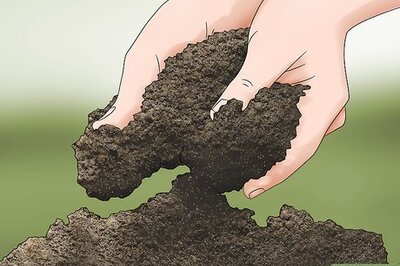
views
Jonathan Bailey, a 30-year-old Amazon warehouse employee in New York City, has a system for protecting himself from the coronavirus at work. He wears a medical mask with a bandanna tied over it. When he returns to the apartment he shares with his wife, he dumps his mask, work gloves, neon green Amazon safety vest and other clothes into a plastic trash bag.
He’s not certain it really works, but he figures it’s better than nothing.
“We’re very careful,” Bailey said. “We’re in the epicenter of it all.”
As millions of Americans heed government orders to hunker down, ordering food and medicines and books and puzzle boards for home delivery, many of Amazon’s 400,000 warehouse workers have stayed on the job, fulfilling the crushing demands of a country suddenly working and learning from home. Orders for Amazon groceries, for example, have been as much as 50 times higher than normal, according to a person with direct knowledge of the business.
The challenge is keeping enough people on the job to fill those orders, according to more than 30 Amazon warehouse workers and current and former corporate employees who spoke with The New York Times. (Many requested anonymity because they were not authorized to speak publicly and feared losing their jobs.) For all of its high-tech sophistication, Amazon’s vast e-commerce business is dependent on an army of workers operating in warehouses they now fear are contaminated with the coronavirus.
“None of this works without our employees,” said Jay Carney, the company’s senior vice president for corporate affairs.
And the employees have been motivated to remind Amazon of their importance.
The surge of orders is testing the limits of Amazon’s vaunted distribution system and forcing changes to the company’s relationship with its employees. While Amazon’s workers are not unionized, the crisis has given workplace organizers like Bailey unexpected leverage to demand better pay, better sick leave and more of a voice in how the company is run.
By mid-March, attendance at Amazon warehouses had fallen as much as 30%, according to one corporate employee involved in the response. This past week, small groups of employees protested working conditions in Michigan and New York. New York state and New York City officials also said they were investigating whether Amazon improperly retaliated against a worker it fired who had been involved in the protest.
Amazon said that it did not fire employees for speaking out about their workplace conditions and that it had fired the worker because he was on paid quarantine and violated safety measures by going to the protest. But in a leaked memo published Thursday by Vice, Amazon’s top lawyer called the fired worker inarticulate and discussed a strategy for making him out to be the face of the worker movement.
David Zapolsky, the general counsel, said he had been frustrated by what he called a safety violation.
“I let my emotions draft my words and get the better of me,” he said.
Sen. Sherrod Brown of Ohio and Sens. Bob Menendez and Cory Booker, both of New Jersey, recently wrote to Amazon’s chief executive, Jeff Bezos, to express concern about warehouse safety. The senators, all Democrats, condemned Zapolsky’s remarks in statements to the Times.
“It’s troubling, racist and has no place in our country,” Menendez said. “Amazon should do everything it can to protect its workers instead of disparaging them.”
Amazon said that at the time he made the comments, Zapolsky was not aware that the fired worker was black.
Amazon’s response to the pandemic has differed from warehouse to warehouse. Over the years, that sort of autonomy has allowed Amazon to nimbly adjust to local market conditions. Now it is leading to distrust, as workers see some facilities close for cleaning while others remain open.
Since the first worker in the New York City facility learned March 18 that he had tested positive, the company has learned of cases in more than 50 other facilities, out of the more than 500 it operates across the county.
In recent weeks, Amazon has raised wages and added quarantine leave, and it is offering overtime at double pay. It said it had tripled its janitorial staff. And it has added space between many workstations. But in private groups, conversations with their managers and public protests, some workers have expressed alarm about their safety.
Carney said the company had been cautious about telling workers about cases out of privacy concerns and because one of its first likely cases, a corporate employee in Europe, turned out not to have the virus. He said Amazon was managing the needs of its workers and the public the best it could in a situation for which no company has a real playbook.
“We’re pushing out these new rules as we decide on them,” Carney said.
But some warehouses acted more rapidly on the policies than others.
“Compliance has been unbelievably good but not perfect,” he said.
On Thursday, Amazon announced that it would audit warehouses’ compliance with the rules.
Warning Signs from China and Italy
For Amazon, like many U.S. companies, the danger of the coronavirus started as a problem in its supply chain. The company was concerned about acquiring products that were made in China, and by mid-February, it was placing larger orders than normal to stockpile supplies.
But Feb. 27, Amazon learned that an employee in Europe who had traveled to Milan had contracted the virus. It immediately halted all nonessential travel, including within the United States, making it the first known major company to suspend domestic travel.
In the first week of March, Amazon told its headquarters employees to work from home. Warehouse employees were later offered unlimited unpaid time off instead. Workers would normally be fired after missing too many shifts, so Carney said the message that executives hoped to convey with the new policy was, “You won’t lose your job, don’t worry.”
On March 16, Jeysson Manrique, an employee of a delivery company that contracts with Amazon, woke up with a fever. His body ached. He called his supervisor to say he was sick. Manrique, 29, was asked to text a picture of his temperature on a thermometer. He couldn’t find one, so he went in for his shift at an Amazon facility in New York.
Amazon said it was investigating the situation with the contracting company because its policy requires employees to stay home if they feel sick.
Two days later, Manrique’s father-in-law — they live together in a house with other members of the family — was sorting packages at the same facility when his doctor called to tell him that he had tested positive for the coronavirus. His father-in-law shared his test results with his supervisors and went home.
When the warehouse closed for cleaning, he was the first publicly known case inside Amazon’s vast warehouse operations in the United States. Manrique joined his father-in-law and other members of the household in quarantine without venturing out for a test.
On March 23, rumors circulated at the New York facility that another employee had tested positive. Hours later, there were whispers of a third. The building was shut down March 24 and March 25 for deep cleaning. The company had also begun instructing warehouses to keep employees apart, stagger their arrivals and cancel group meetings at the start of shifts.
Some workers said they were still handling products that were helpful but hardly critical. One warehouse employee posted a picture on social media of moving large boxes, including a Power Wheels Jeep that a child can ride, with the hashtags #SoManyPingPongTables and #TreadmillsAreEssentialProductsApparently.
Ira Pollock, an employee in the New York City facility who has organized other workers, said having people show up to ship nonessential items endangered the community.
“Amazon has to earn its right to call itself an essential service,” he said.
“The priorities are the priorities,” Carney said. “We’re not going to ship a prom dress or a Ping-Pong table if that’s going to slow down in any way the intake or outflow of essential items.”
A ‘Particularly Insufficient’ Response
When Amazon announced unlimited unpaid leave, it also said it would pay two weeks of sick time for “all Amazon employees diagnosed with COVID-19 or placed into quarantine.” On Friday, a day after it received questions from The Times about the situation, Amazon said it had issued a check for Manrique’s father-in-law, who is ending his second week of quarantine.
Documents viewed by The Times show that workers around the country applied for leave without a formal diagnosis. The workers said they had compromised immune systems or had been ordered to stay home because of contact with someone who was sick but did not have the paperwork required to qualify for paid time off.
In a number of cases, employees continued to work after showing symptoms but before their tests came back positive — when they would be eligible for paid leave. One person in New York started having symptoms March 18 but did not stop working until March 25, when she went into quarantine, the documents show.
Amazon said workers could still use unlimited unpaid or regular paid sick time off, if they had accrued enough hours.
“Paid leave is important,” said Dr. David Michaels, a former head of the Occupational Safety and Health Administration who teaches at George Washington University, “because you need to do everything you can to ensure that potentially sick workers stay home in order not to infect co-workers and others in the public.”
On March 25, the attorneys general in 14 states and Washington, D.C., wrote a letter to Amazon saying the requirement for testing or a formal quarantine was “particularly insufficient given the realities of the public health crisis, where the lack of access to COVID-19 testing has been widely reported.”
Two days later, Amazon expanded its policy.
But the message has not reached everyone. The internal website for warehouse employees has not been updated, and Monday, a warehouse employee in the South asked for paid leave after her child tested positive. In an email viewed by the Times, the employee was told to take unpaid time off “as you wait for test results.”
While Amazon said it could not confirm the situation, it added that that response did not reflect its policy and that any employee caring for someone with a doctor-diagnosed case of COVID-19 should receive up to two weeks of pay.
Karen Weise and Kate Conger c.2020 The New York Times Company


















Comments
0 comment